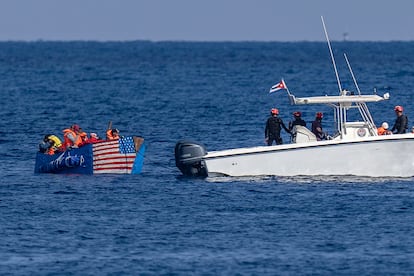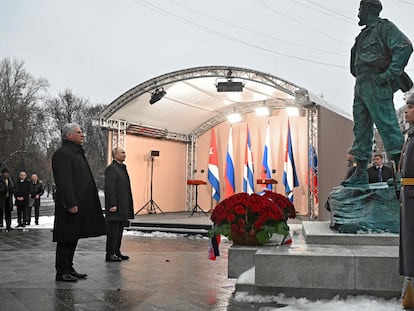The Cuban migration crisis: Biggest exodus in history holds key to Havana-Washington relations
A makeshift boat with a US flag on its bow was caught drifting off the Malecón, in a powerful symbol of the problems afflicting the island nation for over a year

A migrant raft floating in broad daylight right off Havana’s famous Malecón seawall in 2022? It may sound unlikely, but it happened this Monday, quickly becoming a symbol and a reflection of the migratory crisis that has been tearing Cuba apart for a year.
The scene surprised tourists and onlookers who were walking along the capital’s seafront esplanade, near the United States Embassy, which reopened during the diplomatic thaw encouraged by former president Barack Obama, in 2015.
In those days, despite the old enduring dispute between the two countries, 24 agreements were signed between both governments. One of the points on which there was the greatest agreement was the need to regulate “disorderly” migratory flows.
But relations went downhill under former US president Donald Trump, who undid Obama’s rapprochement with Havana, dismantled the consulate and took the sanctions and embargo to new levels, measures that Cubans consider the ultimate cause of their intensifying hardships.
This Monday, under the December sun, a makeshift boat with an American flag painted on the bow suddenly showed up off the Havana coast, carrying a dozen people on board. Like thousands of other Cubans in recent months, this group had been trying to reach the coasts of Florida, but apparently the boat engine broke down and the rafters were left at the mercy of the waves, which carried them to the edge of the Malecón until the coast guard showed up and towed them away. Onlookers witnessing the scene from the esplanade could not believe their eyes.
It had been over 28 years since a similar scene was seen in this noble area of Havana. The last time was the summer of 1994 when, in the middle of another serious economic downturn on the island, the so-called “balsero” crisis broke out, sending around 35,000 people in search of a better life abroad. The Cuban government at the time gave the rafters free rein, and dozens of flimsy boats carrying migrants left for the US from the Malecón, which became a makeshift shipyard. Both countries quickly signed immigration agreements that are still in force today, putting an end to that exodus.
Hundreds of thousands of Cubans continue to wait for real changes to take place in their country that will give them enough hope to stay
Almost three decades later, the Cuban economy is once again tanking and the hardships of the population have intensified to the point of resembling, or even exceeding, the deficiencies of the so-called Special Period of the 1990s triggered by the dissolution of the Soviet Union. According to Washington DC data, in the last two months alone close to 3,000 Cubans have been intercepted at sea by the US Coast Guard, while 500 managed to set foot on American territory (during the last US fiscal year, from October 1, 2021, to September 30, around 6,000 Cubans were deported.)
Figures from the US Customs and Border Protection Office are even more compelling: in fiscal year 2021, 224,000 illegal Cuban migrants entered US territory through its southern border, to which must be added the 29,000 who entered last October. That is more than 253,000 people in just 13 months, and all forecasts suggest a similar trend for November and December. If so, this means that almost 3% of the Cuban population would have immigrated to the US through irregular routes during this period of time.
Most of these people made their way to the US across Central American nations after Nicaragua eliminated entry visa requirements for Cuban citizens in November of last year. Dozens of people have died during this risky journey, which can cost each traveler between $8,000 and $10,000 in airfare, payment to people smugglers, bribes for officials and various other expenses. Besides the personal hardship it entails, this migratory flow is also mortgaging the future of Cuba, say local economists and sociologists, since most of those leaving the island are young people, many of them university students or working professionals.
The current tide of emigration is already twice the size of the historic “Mariel exodus” of 1980, when 125,000 Cubans left the country. The paradox is that these days, the US does not want the Cuban migrants and is trying to put an end to this crisis through discreet negotiations with Havana.
The powerful image of a raft on the Havana seawall this past Monday has several readings. On one hand, it evidences that nothing can curb Cubans’ desire to emigrate amid a crisis that is causing blackouts of up to 12 hours a day, runaway inflation, an unprecedented deterioration of public health services and government employee salaries so low that precious little can be bought with them. And migration, which has always been a key element in Cuba-US relations, is once again taking center stage at a time of timid attempts at rapprochement between the government of Miguel Díaz-Canel and the Joe Biden administration.
For the US, it is Cuba’s inability to provide citizens with basic services like electricity that is encouraging the current exodus, while for the Díaz-Canel government, it is the suffocating embargo and the US policy of benefits for Cuban migrants, even those arriving illegally, that is fomenting the mass departures. In this loop of mutual accusations, ordinary citizens are like ping-pong balls, subject to the fluctuations of political circumstances and behind-the-scenes negotiations beyond their control.
Although very cautiously, under President Biden there have been some steps towards closer relations. Washington has not returned to Obama’s positions, but it has dismantled some of Trump’s most suffocating policies and eliminated restrictions on remittances and direct flights, in addition to authorizing group trips to the island. It has also just restored operations at the consulate, which will grant a minimum of 20,000 migrant visas to Cuban citizens a year, a measure that Havana considers “positive” but “insufficient.” Under Biden, talks between high-level officials to deal with immigration issues have also resumed, something that Trump had liquidated. Both countries have declared that they want to make progress on this matter, and at the latest bilateral talks, just a few weeks ago, Cuba agreed to accept flights with deported Cubans that the US turns away, even those who entered through the Mexican border, something that had not happened since the Obama era.
There are other key issues to resolve. Obama removed Cuba from the list of countries that sponsor terrorism, and Trump put it back a week before leaving power. Now the focus is on the possibility that the US could once again remove Havana from a list that entails financial sanctions and numerous logistical difficulties for Cuba, in exchange for gestures in favor of human rights, particularly in connection with the individuals who were imprisoned as a result of the demonstrations of July 11, 2021.
In reality, very little information has emerged about the content of these conversations. The only certain facts are the ones that have been made public, such as the US decision to include Cuba in another blacklist for its policy of “religious discrimination,” something that has been rejected even by the biggest critics of the Cuban government. In the meantime, delegations of senior officials and entrepreneurs have been visiting the island.
In the midst of these debates, contacts and conversations, hundreds of thousands of Cubans continue to wait for real changes to take place in their country that will give them enough hope to stay. They are also hoping that the United States, under Biden, will return to the policies of the Obama era, when there was no immigration crisis. Or at least that’s what they say.
Sign up for our weekly newsletter to get more English-language news coverage from EL PAÍS USA Edition
Tu suscripción se está usando en otro dispositivo
¿Quieres añadir otro usuario a tu suscripción?
Si continúas leyendo en este dispositivo, no se podrá leer en el otro.
FlechaTu suscripción se está usando en otro dispositivo y solo puedes acceder a EL PAÍS desde un dispositivo a la vez.
Si quieres compartir tu cuenta, cambia tu suscripción a la modalidad Premium, así podrás añadir otro usuario. Cada uno accederá con su propia cuenta de email, lo que os permitirá personalizar vuestra experiencia en EL PAÍS.
¿Tienes una suscripción de empresa? Accede aquí para contratar más cuentas.
En el caso de no saber quién está usando tu cuenta, te recomendamos cambiar tu contraseña aquí.
Si decides continuar compartiendo tu cuenta, este mensaje se mostrará en tu dispositivo y en el de la otra persona que está usando tu cuenta de forma indefinida, afectando a tu experiencia de lectura. Puedes consultar aquí los términos y condiciones de la suscripción digital.
More information
Archived In
Últimas noticias
Welcome to the post-religion era: The idea of Christianity as the absolute truth has become obsolete
‘I thought you would like it’: The risky sexual practice popularized by TV shows and TikTok
The digitalization of tourism: ‘They promise experiences and gave us the worst possible one’
Mexican peso defies uncertainty with forecasts of a new period of stability in 2026
Most viewed
- Sinaloa Cartel war is taking its toll on Los Chapitos
- Reinhard Genzel, Nobel laureate in physics: ‘One-minute videos will never give you the truth’
- Oona Chaplin: ‘I told James Cameron that I was living in a treehouse and starting a permaculture project with a friend’
- Why the price of coffee has skyrocketed: from Brazilian plantations to specialty coffee houses
- Silver prices are going crazy: This is what’s fueling the rally










































